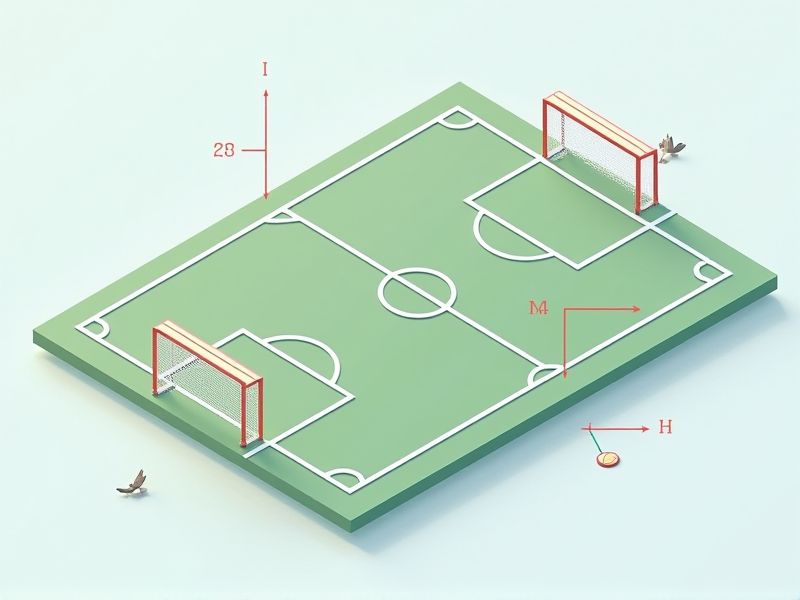
The standard dimensions of a futsal court, as set by FIFA, are typically 40 meters in length and 20 meters in width for international matches. For local play, courts can range from 25 to 42 meters long and 16 to 25 meters wide, offering some flexibility depending on available space. The penalty area is a semi-circle with a 6-meter radius from each goalpost, ensuring clear zones for defensive and offensive actions. Goals are smaller than those in football, measuring 3 meters wide and 2 meters high, which helps to encourage skillful play and quick decision-making.
Length: 25-42 Meters
A standard futsal court measures between 25 to 42 meters in length, allowing for various configurations suitable for different levels of play. The width complements the length, with standard dimensions ranging from 16 to 25 meters. This regulation size ensures gameplay is fast-paced and emphasizes skill, as players navigate a compact space. When measuring your futsal court, ensure it meets these guidelines for an optimal playing experience.
Width: 16-25 Meters
The standard width of a futsal court ranges from 16 to 25 meters, ensuring enough space for dynamic play and player movement. This width promotes skillful ball control and enhances team strategies in a confined area. Adhering to these dimensions allows for a standardized playing experience across competitive leagues. For optimal gameplay, you should familiarize yourself with these measurements as they greatly impact your tactical approach.
Goal Dimensions: 3 Meters Wide
The standard dimensions for a futsal goal are 3 meters in width and 2 meters in height, emphasizing the need for precision in design and construction. Futsal courts, typically measuring 25 to 42 meters in length and 16 to 25 meters in width, must accommodate these goal specifications to ensure compliance with international regulations. The size of the goal plays a crucial role in the dynamic nature of the game, impacting scoring opportunities and goalkeeper strategies. Understanding these dimensions is key for anyone involved in futsal, from players to coaches, to create an optimal playing environment.
Goalpost Height: 2 Meters
The standard height for a futsal goalpost is precisely 2 meters, ensuring that the game maintains a consistent challenge for both players and goalkeepers. This height allows for skillful shots and saves, enhancing the overall competitive experience. Futsal courts also dictate a goal width of 3 meters, complementing the dimensions of the 40 x 20-meter playing area. Understanding these specifications can help you better appreciate the technical aspects of the sport.
Penalty Area Line: 6 Meters From Goal
The standard futsal court features a penalty area line set precisely 6 meters from the goal. This designated area plays a crucial role during penalty kicks, highlighting its importance in game strategy. The penalty area itself measures 3 meters in width, ensuring clarity in play conditions within this zone. Understanding this measurement is essential for players and coaches aiming to maximize scoring opportunities in competitive matches.
Center Circle Radius: 3 Meters
The standard futsal court features a center circle with a radius of 3 meters, designed to facilitate player movement and ball gameplay. This circular area is crucial for ensuring proper spacing during kick-offs and restarts, allowing players to maintain a strategic distance. Each futsal match is played on a rectangular court measuring 25 to 42 meters in length and 16 to 25 meters in width, adhering to the official regulations set by FIFA. Understanding these dimensions enhances your appreciation of the sport and its tactical elements.
Substitution Area: Near Sideline
The substitution area in a futsal court is crucial for player management and flow of the game, positioned near the sideline. This area is typically 5 meters long and spans the length of the goal area, ensuring smooth transitions during player replacements. Each team has designated entry and exit points to facilitate quick substitutions without disrupting the gameplay. Understanding the layout of the substitution area is essential for maintaining the pace and strategy of your team's performance.
Penalty Mark: 6 Meters From Goal
The futsal court is designed with specific dimensions to enhance gameplay, with the penalty mark positioned precisely 6 meters from the goal line. This key measurement is essential for ensuring fairness during penalty kicks, allowing players the opportunity to take direct shots on goal under regulated conditions. Understanding this distance helps players and coaches strategize effectively, as it dictates the placement and execution of crucial plays within the game. Maintaining awareness of the 6-meter penalty mark can significantly impact scoring opportunities during competitive matches.
Second Penalty Mark: 10 Meters From Goal
In futsal, the second penalty mark is a crucial aspect of the court's layout, located precisely 10 meters from the goal line. This distance is standardized to maintain consistency across all levels of play, ensuring fairness in penalty situations. During a penalty shootout or a direct free kick taken from this mark, players must understand the significance of distance and angle when aiming at the goal. Proper adherence to this regulation enhances the game's competitive integrity and provides players with an equal opportunity to score.
Field Markings: White Lines
A futsal court measures 25 to 42 meters in length and 16 to 25 meters in width, with precise field markings defined by white lines. The center circle, with a radius of 3 meters, ensures clear positioning for kick-off and re-starts after stoppages. The penalty area, marked by a rectangle measuring 6 meters from the goal line, delineates the space where specific fouls result in direct free kicks. Understanding these markings is essential for both players and referees to maintain the integrity of the game.
